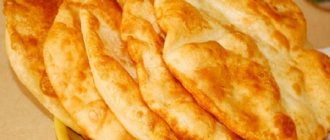Khash soup is an interesting first dish, popular in the Caucasus. Historians claim that the recipe for such a dish was first mentioned in Armenian sources of the 12th century.
The dish owes its appearance to the tradition of sacrificing cattle, and the tripe and legs, unsuitable for offerings, were given to the poor. So they began to prepare a rich soup using tripe (the largest part of the stomach of a ruminant animal) and beef legs with garlic seasoning.
Description of preparation:
This soup is widespread throughout the Caucasus.
It was considered a ritual dish and was called the “dish of the poor,” because after the sacrifice, the poor were given entrails and bones, from which this tasty and nutritious soup was cooked. This soup was served in the morning for breakfast to satiate a person for the whole day. In addition, it is also very beneficial for our bones. The greens can be anything you like. Bon appetit! Purpose: For lunch / For dinner Main ingredient: Meat / Beef Dish: Soups Geography of cuisine: Armenian / Caucasian
Presentation of khash
Traditionally, khash is served early in the morning. It serves either as the main course for breakfast or precedes it.
Laying out the soup is a separate procedure, the benefit of which is that all the vitamins and phytoncides contained in garlic and herbs are preserved:
- The garlic is peeled, crushed, and ground with salt.
- The garlic mass is spread out in portions.
- The greens are chopped.
- Hot soup is poured into plates and meat is laid out.
- The portion is generously sprinkled with herbs.
In addition to the soup, lavash and grated radish are served.
Soup variations
In addition to the above-mentioned products, Georgians add beef kidney fat and rennet, which is also part of the stomach of a ruminant animal, to khash. 20 minutes before the end of cooking, add white bread soaked in hot milk and wine vinegar into the soup.
In Azerbaijan, ram is used to prepare khash, called here kelle pacha. In addition to the scar and hooves, they also use the head.
In contact with
How to cook “Armenian khash”
Prepare all the necessary ingredients.
Treat beef legs and soak in cold water for one day. Then cut into pieces.
Place the legs in a saucepan and cover with water. Bring to a boil and simmer over low heat for 7.5 hours. Add salt, bay and pepper. Cook for another 30 minutes.
In another saucepan, cook the processed tripe until tender. Finally, add salt to taste. Remove, cool and cut into strips.
Remove the legs and separate the meat. Strain the broth and return the meat to it, add the tripe and bring to a boil.
Chop the garlic and grind with salt.
Peel the radish, grate it on a coarse grater and add salt.
Place garlic on a plate, pour hot khash, sprinkle with chopped herbs and serve with radish salad and thin pita bread.
Bon appetit!
Georgian khashi recipe
If you have finally decided to cook this dish and have prepared everything in advance, then below is a classic recipe for preparing Georgian khashi at home. You need to calculate in advance when the longest period will be, that is, cooking. Many people prefer to do this at night, since this is the best option in terms of time. But we must not forget that even under the lid, the water still evaporates, so you need to add it at least once.
Components:
- beef leg;
- scar;
- any greens;
- head of garlic;
- salt.
Preparation:
- Rinse the leg thoroughly and place it in the pan. If it is put into a container, then it is not necessary to cut it. It takes longer to cook, but the broth turns out tastier.
- Cut the tripe into strips and also place in the pan.
- Fill with cold water, do not add salt under any circumstances.
- Place over high heat; as soon as the broth boils, cover with a lid, opening slightly, and reduce the gas to low.
- Hashi is cooked for 5 to 8 hours, depending on many factors. Readiness is determined as follows: if the skin easily comes away from the leg with the help of a fork, then the soup is ready.
- Now you need to strain it. To do this, first remove all the products from the broth into a separate bowl. Place gauze, folded in several layers, in a colander and strain the broth into another, smaller pan.
- All soft parts are crushed, boned and placed in the broth.
- The garlic needs to be peeled and finely chopped. Remove the greens from the branches and chop finely.
- You can immediately salt the broth, and put a little garlic and herbs into each plate.
Hashi is stored in the refrigerator for 3-4 days.
Video:
Beef khash recipe
Beef khash recipe
Ingredients:
- beef leg - 1 pc.;
- tripe - 1 kg;
- onions - 3 pcs.;
- garlic - 2 heads;
- Bay leaf;
- vinegar;
- salt, spices - to taste.
Preparation
- Season the meat before cooking. This can be done using a burner with an open flame. Hold the beef leg over the fire, and then remove the top layer with a knife.
- Fill a container with cold water and place the meat in it. Leave for 3-4 hours.
- Cut the tripe into small pieces and cook in a separate pan until it is tender. Once cooked, cut into thin strips.
- Cut the beef legs, removing any excess fat.
- Fill a deep pan with water and place the meat to simmer over low heat. The process will take 8-10 hours. Beef can be considered ready only after the meat is completely separated from the bone.
- Add vegetables, salt, spices. Cook for about two more hours. Only then add the tripe.
- Mix vinegar, salt, garlic. Season the finished dish with the resulting sauce.
- The soup should be served with soft pita bread, sprinkled with fresh herbs.
hash
On the website page where the recipe for making jellied meat is presented, I explained in a few words how you can get khash and in particular in the 9th photo I showed and told that after a long cooking of beef shanks you can get a wonderful, rich broth - khash.
However, khash made from beef legs using tripe (tripe or belly) is considered traditional, so to speak, “legal.”
If you delve into the history of the origin of khash, you can identify a fact that allows you to classify this dish in those distant times as the food of the poor. Tradition says that after slaughtering a cow, wealthy Armenians used all parts of the carcass for food, with the exception of the legs and head, and threw them in the trash. But ordinary people took advantage of this, did not disdain it, brought the food home and, after lengthy processing, cooked a wonderful broth, which later became known throughout the world as khash.
Why is the dish called khash? I do not presume to say this, since I am not a linguist of the Armenian language, but as an Armenian who speaks her native language, I can draw my own conclusions and assume the following. The word hashel (խաշել) is a verb, which translated into Russian means to cook and the root hash, corresponding to the noun var, comes to mind twice more in Armenian dishes, khashlama and hashil, where the name itself means the cooking process and not, say, frying or baking...
Since not much time is spent on khashlama and hashil, in all likelihood, our ancestors, after a long, patient, “marathon” cooking - and the dish was cooked for a long 7-8 hours - finally opened the lid of the pan and tasted the wonderful aroma coming from there, they exclaimed with their souls: “Wah, wah hash, hash is ready!”, removing the suffix ate, since they no longer had the strength to pronounce it.
And, judge for yourself, before the owner of the brew enthusiastically uttered these words, he painfully spent a whole week of painstaking work cleaning the bristles from beef legs, which had to be removed so scrupulously that God forbid, not a single hair leaked into the broth after cooking . Yes, after that it was necessary to change the cloudy water twice a day for a whole week until it became clear and suitable for cooking.
I do not undertake to talk about the special technology for cleaning literally brown tripe, since I do not have it, which, after a long, special processing, turns into a soft, white edible skin without the inherent smell that is heavy before cleaning, since now it is sold already peeled.
The poor, eating “scraps from the master’s table,” without knowing it, looked much healthier, more cheerful and with a beautiful complexion than their rich owners, who ate cow meat (beef) itself.
Nowadays, when science has the ability to determine the composition of any product, we can learn about their benefits and harms, and this also applies to beef legs, which contain vitamins B, A and D, as well as chemical elements such as potassium, magnesium, calcium, selenium, zinc, manganese, iron.
Several years ago, when I literally could not walk due to pain and swelling in my knees, I turned to a famous orthopedist at the Yerevan medical commission, who, having professionally removed the accumulated fluid in the knee joint, simply said: eat celery at least every day (which prevents swelling) and drink it down ...you won't believe it... with a glass of khash! And, laughing, he added: “Yes, yes, dear lady, khash is a natural, healthy product, an analogue of which is known to everyone in the form of rather expensive pills called “Teraflex”, which we prescribe to patients with problems with the musculoskeletal system.” . And in the end I reassured me that I would also get rid of the cramps that tormented me at night.
I read the pharmacological actions of “Teraflex” and, according to the doctor’s words, khash consists of those necessary elements that stimulate the regeneration of cartilage tissue, moreover, enable the formation of new healthy cartilage tissue, preventing its damage. The nutrients found in rich beef leg broth stimulate the formation of hyaluronic acid, which is part of the connective tissue responsible for skin elasticity.
Here it becomes clear why the poor in the past looked healthier, more cheerful, and more productive than the obese rich.
Now, after we got a little acquainted with the beneficial properties of khash (and I want to remind you that everything in food is wonderful in moderation, since khash is quite a high-calorie dish), I would like to remind you that, among other things, khash is a delicious dish, the season of which starts in mid-October and lasts until late March or mid-April, depending on the weather. In a word, khash is not a summer food, but a winter one.
On the “Kholodets” page, I have already described a little about those rituals that were carried out in the carefree Soviet times and I don’t want to repeat myself, I will only say that now rarely anyone prepares khash at home, and people prefer not to waste time and are more often found in restaurants, where it is excellent prepare this dish.
In our family, three members, even four (I am from October, and there are also cold years when...) were born within the framework of the “hash time period” and therefore we cook it at home from time to time.
I would also like to add that it is now incomparably easy to prepare it, since they are sold in a perfectly cleaned state, that is, without a single bristle, and all that remains is to change the water several times for a couple of days until it becomes transparent and removes the heavy smell inherent in beef legs and tripe.
Now I’ll describe the work in more detail: we bought the legs and tripe on Friday morning, changing the water for two days, first three times, and the next day twice, and on Saturday evening at 18.30 we started boiling them in clean, cold, completely clear water.
We brought the water to a boil, drained it, rinsed both the pan and the legs, returned them to the pan, poured in the water a second time, brought it to a boil again, but we didn’t like it either (there was also a slight smell specific to the legs), we had to drain the water a second time and only on the third try did we like the brew we set to work on. Yes, of course, when the boiling water was drained, fat was also poured out, but in the end there was enough of it.
Ideally, you should cook khash in large enamel pans. Well, my 20 liter was used for pickles, so at first we used an 8 liter stainless steel pan, but it turned out that the legs were a bit cramped here and we had to transfer them all into a large 15 liter aluminum pan, which is less desirable, since there is a risk of darkening the broth, not counting the walls of the pan themselves. But in the end, our fear was not confirmed, the khash turned out to be light and rich, and yet I again poured it into stainless steel in its finished form.
We cooked the khash from 7 pm to 1 am over medium heat, pouring 12 liters of cold water into a pan with two legs, then turned off the heat and cooked again in the morning from 7 to 9-9.30. As a result, 4 liters of liquid remained - that is, the khash itself, not counting the meat.
The tripe must be cooked separately and also soaked for a day until transparent, then it is also brought to a boil twice and the water is drained, and each time a new cold portion is poured into the pan. The third time, the tripe is kept for 4-5 hours in a saline solution (2 tablespoons of salt per 3 liters of water), then washed again and boiled for several minutes to remove all the salt, and only after this whole procedure is a new portion of cold water poured in and the tripe is boiled, I emphasize again, in a separate pan until tender for 4.5-5 hours. And then not a single unpleasant, heavy spirit or smell is present here.
All that needs to be served with khash is dry pita bread in order to crumble it into the broth, but before that you need to season it with salt and garlic, since they are not added to a common pan during cooking, but are served separately in appropriate trays. The pita bread should be dried naturally in the air a day or two before serving, simply by laying it out on a tray. It is convenient for crumbling into a plate, drying the pita bread in the form of tubes, but this is not important.
In addition to garlic and salt, various pickles, tsitsak - salted pepper, marinades, also fresh radishes, herbs, cheese, mineral water and vodka are very suitable for khash. That's all!
Khash is served in a large, wide, deep soup bowl, with broth and leg meat poured in, and a snack plate is placed next to it to place the meat in. The meat, in turn, is covered with fresh pita bread to keep it warm. The broth is brought to taste by adding garlic and salt, stirring and crumbling the pita bread. That's it, now you can enjoy a wonderful meal!











